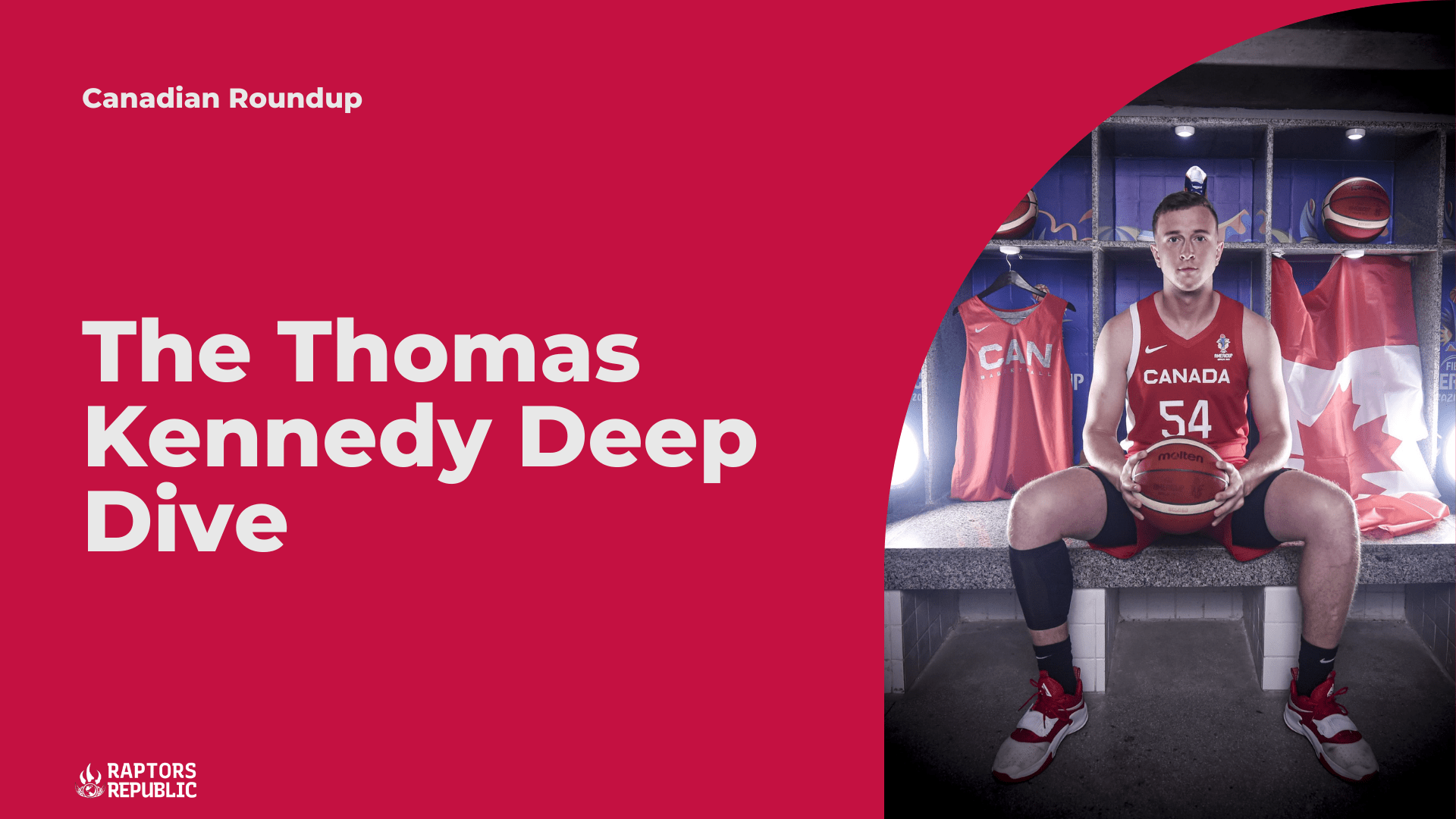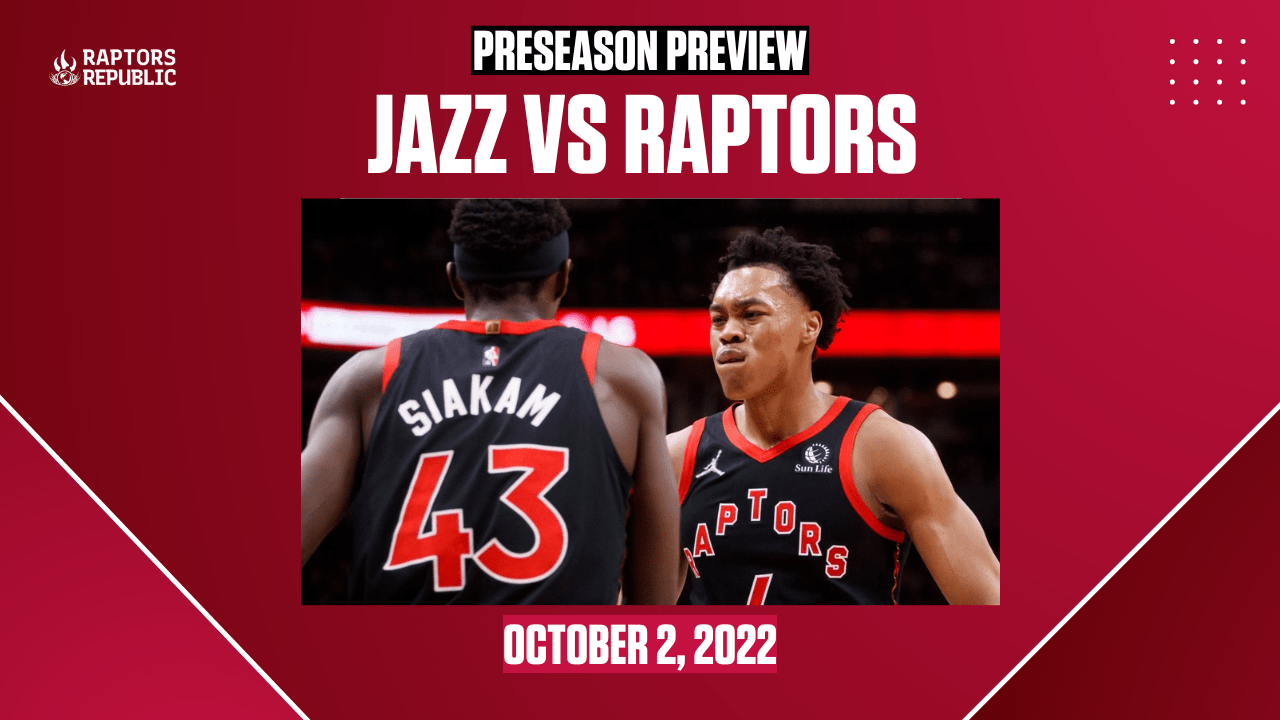Despite being the youngest player on the AmeriCup roster, Thomas Kennedy played an integral role, averaging 19.7 minutes per game, the 5th highest on the team. With Canada’s lack of depth at the center position, Thomas Kennedy figures to be a program veteran as his career progresses, especially for the winter core. What can Canada Basketball fans expect from Thomas Kennedy?
A quick look at the stat sheet and the University of Windsor senior’s numbers at the AmeriCup tournament look uninspiring. Kennedy averaged 6.2 PPG along with 3.5 REB on 53.6/0/50 shooting splits. As Canada entered the knockout stages, Kennedy saw his minutes decrease, going from 23.67 minutes in the group stages to 16 minutes per game (coach Mitchell going away from lineups featuring multiple bigs probably played a role in the decrease). However, a lot of Thomas Kennedy’s value at this stage of his career goes unnoticed by the box score. So let’s dive deep into his AmeriCup film and get a clearer picture of the player Thomas Kennedy is.
Offense
At this stage, I would define Thomas Kennedy as a “1 level scorer”. A quick look at his shot efficiency and its clear he’s not an outside shooter (outside here means outside the paint) at this point of his career, restricted to almost exclusively scoring underneath the basket.
| AmeriCup | USports (career, 66 games) | CEBL (career, 27 games) | |
| FG% | 53.6 | 49.5 | 53.3 |
| 2P% | 57.7 | 53.0 | 58.4 |
| 3P% | 0.0 | 17.8 | 16.7 |
| FT% | 50.0 | 62.9 | 52.3 |
Standing at just 6’9″ Kennedy is undersized as a center and his lack of vertical athleticism forces him to be fairly floor-bound, especially in traffic. As a result, Kennedy is not much of a vertical offensive threat, diminishing his value as a scorer when he’s rolling to the basket.
Despite his physical limitations, what really makes Kennedy a limited offensive player is his poor touch. These one-hand push shots require a level of finesse that just does not exist in Kennedy’s offensive repertoire at the moment.
Even with his dominant right hand, Kennedy’s struggles with his touch were apparent. Here Kennedy misses a point blank layup by putting the ball up too low on the backboard. Now there was some contact from the Brazilian defender, but this shot attempt certainly should have been converted and probably would have been if Kennedy’s touch was more accurate.
With his left, Kennedy’s touch is a lot worse. On this sequence, he tries to create a shot for himself on the fake handoff and it does not turn out well for him. Minor silver lining for me is Kennedy looked comfortable as the decision maker on this play and especially when executing the strong drive and spin. It was an interesting flash into his movement skills and handle.
When he’s forced into situations where he has to create a shot after his initial move is shut down by his defender, he really struggles to get a good look. Here, his smaller stature does not allow Kennedy to seal the defender with his drop step and he’s unable to create an advantage.
Throughout the tournament he did begin to develop some chemistry in the PNR with Dalano Banton. Kennedy actually has some decent movement skills and is pretty nimble and agile on his rolls to the basket. Most of the time when Kennedy scored as the roller it was a wide open layup or dunk. However, he did have a few tougher baskets, with this zero dribble dive to the basket in traffic being the highlight for me.
So why would I be interested in Thomas Kennedy future with the SMNT, given his struggles scoring? Well, the answer is he had some impressive flashes passing the ball. At the AmeriCup, Kennedy averaged just 1.3 APG at the the tournament. Interestingly, he picked up all of his assists in the group stage games. All this to say his passing is much more advanced and valuable than the 1.3 APG might suggest.
With his limits as a scorer, I don’t think Kennedy will ever have the scoring gravity to stretch defenses by himself and open up passing lanes for his teammates. However, as a connective passer and decision maker, I strongly believe Kennedy will be able to convert and extend on advantages his teammates create. All of a sudden, he becomes a little more valuable on the offensive end.
Throughout the AmeriCup, coach Mitchell gave Kennedy some decision making reps when catching the ball above the 3 point line. Most of the time, these situations flowed into a handoff ball screen from Kennedy. But on this sequence he recognizes Banton’s defender is out of position and feathers in a well-located pass.
And for keen-eyed Raptors fans, this 3-man alignment might look familiar, except with future Hall-of-Famer Marc Gasol processing and delivering the pass.
In the post, Kennedy again flashed some great court mapping. Even before he takes a dribble, you can see him scanning and processing the rest of the court. He delivers the pass slightly behind the cutting Kigab, the perfect place for the ball with Meeks rotating, which makes me wonder if it was intentional. If Kennedy placed the ball a little more in front of Kigab, it is probably deflected by Meeks leading to a live ball turnover.
Making these passes and reads at a standstill is already a step above many professional bigs. But Kennedy really shines when he’s passing on the move, specifically on the short roll. On this roll, Kennedy sees the help, collects his feet and fires an accurate pass, over his head, to the corner all in one motion, without taking a dribble. Definitely some high level processing to find the pass, but also some nice movement skills on display to execute the play. Kennedy’s combination of passing touch, processing, and nimble feet makes me think he will thrive in the short roll at the pro level, especially as he develops his already surprisingly decent handle and gains more reps.
This transition sequence actually blew me away. Most players might have hit Henry-Blair in the right corner as it is a much easier pass to make, but Kennedy elects the cross court pass to a wide open Gray where the 5’11” Paul Stoll has no chance of contesting. Despite not being an elite vertical athlete, Kennedy definitely displays some impressive fluid athleticism with the ball in his hands.
These flashes of passing the ball, especially on the move, made me curious to see if Kennedy always had this type of passing acumen. Last season with the Windsor Lancers, Kennedy averaged a career-high 3.6 APG in 34.1 MPG. From his sophomore to junior seasons, Kennedy saw a jump in his total assists (56 -> 62) despite playing 6 less games. Diving into some of his university and even prep high school film, it is pretty clear Kennedy’s passing and vision has been a part of his game for quite a while. And judging by the numbers, Kennedy’s passing is beginning to become more effective as his game matures.
And I just wanted to highlight this hilariously creative assist he pulled off in high school.
It is interesting to me that Kennedy has such advanced passing touch for his size and age, despite having major struggles with his scoring touch. I’m actually not too sure myself how common or uncommon this intersection of skills is in prospects , which may be worth its own deep dive.
Defense
On the defensive end is really where Thomas Kennedy’s physical limitations hurt the most. At his height and lack of vertical pop, he’s not much of a rim protector. I didn’t find anything about Kennedy’s wingspan, but on the court his length does not stand out. In the 6 games in the AmeriCup, Kennedy averaged a measly 0.3 blocks per game. Here he gets beat on the backdoor cut by Gary Clark (NBA journeymen). Kennedy realizes it pretty quickly (credit for the defensive awareness) but unfortunately his contest is just a little bit short of Clark’s layup attempt. Though this is probably an unfair matchup for Kennedy to battle an NBA-level athlete in the air.
Another instance of Kennedy’s poor rim protection. This time on the drive, Kennedy starts out of position to contest the shot, which is a really bad place for him. Since he’s not a quick-twitch explosive athlete, he’s not able to fix his positional mistakes on defense with an incredible athletic play. Instead it results in him giving up the and-1 opportunity.
Kennedy is usually playing drop in PNR defense, which makes sense given his tools. However, this sequence was an unfortunate accumulation of all his physical limitations combined in one. As he’s dropping, he struggles with backpedaling and seems to lose momentum with each step. As a result, Kennedy is stuck in no man’s land, not deterring the ball handler from getting downhill and not staying close enough to the roller. And finally, we see Brazil take advantage with a lob, testing Kennedy in the air.
While Kennedy may not be the most physically gifted defender, he is a smart, aware and active defender. He still an overall net negative on the defensive end, but his activity saves him from being a total lost cause. In the AmeriCup, Kennedy routinely made great rotations and averaged 1.0 steals in just 19.7 minutes per game, which was tied for 3rd on the team.
On this sequence here, his defensive processing and activity are on full display as he plays the drop to perfection. Contains the drive, and then rotates back over to the roller, all while keeping an eye on the player with the ball. As a result, he’s in perfect position to sniff out the bounce pass and deflects it with his active hands.
I think the processing and court mapping Kennedy uses to be a great passer helps his anticipation positioning and rotations on the defensive end. This is not a novel idea, but it does apply to Kennedy. When the post entry pass is released, Kennedy’s already shuffling over after recognizing the mismatch in the post. On the catch, he immediately shows a hard double, at a good angle as well, helping force a turnover.
The nimble feet that help Kennedy be so effective in the short roll also help him with sliding laterally on defense. I still wouldn’t say he’s mobile, not to the degree that I would be comfortable with Kennedy switching even infrequently on PNR’s, but against other FIBA bigs with shaky handles he can hold his own. He’s also incredibly strong, which allows him to absorb contact really well and still contest shots, even without jumping off the ground. Avoiding the aerial battle will always be a better situation for Kennedy on defense. Kennedy does it all well here, from sliding his feet to absorbing the contact, against the incredibly explosive Zylan Cheatham.
And this play was my favourite defensive sequence from Kennedy in the whole tournament. I think the sequence really highlights all of Kennedy’s defensive strengths. He’s forced to cover a ton of ground and his change of direction mobility shines. Also notice how his right hand is already up in the air on the opponent’s drive, prepared to contest a shot but also ready to pounce for a strip the second the ball is exposed, which he ends up doing here. End result, Kennedy turns an advantageous situation for the opposing team into a turnover.
That kind of anticipation and hand placement on defense was Marc Gasol-like. Now Kennedy is nowhere near the defender Gasol is, but I think he’s a much better defender than his athletic limitations would suggest.
Final Thoughts
It was a successful summer for Thomas Kennedy after representing Canada at both the GLOBAL JAM (U23 event) as well as at the AmeriCup. This was my first opportunity to watch Thomas Kennedy and there were definitely some flashes that caught my eye. His passing can become a really interesting fit along more traditional shot creators and I believe in his defensive activity keeping his defensive value afloat despite his physical limitations.
The real swing skill for Kennedy will be his shooting. Unfortunately at this point in his career, Kennedy does not bend the defense enough with his scoring. He’s limited to scoring around the restricted area and even there, his poor touch can complicate things. Developing a semi-consistent shot outside the paint, and eventually beyond the arc would do wonders for his game. Kennedy’s shooting development is going to determine his offensive value in the future and what pro level he ends up reaching. Based on his current shooting splits and touch, I would not expect incredible improvements as a shooter, but crazier developmental curves have happened.
Overall, I think Thomas Kennedy immediately offers some much needed frontcourt insurance for the Senior Men’s “Winter Core” for the next 2 World Cup qualifier windows. Given his age and some of his tools, there’s a future for him as well to become a larger part of the “Winter Core” (perhaps a program staple?) as he continues his development. Regardless of where his career takes him, Thomas Kennedy is another name for Canada Basketball fans to monitor moving forward.



